Brief

At a Glance
- Fast-growing tech companies that also relentlessly attack their costs generate an outsize reward for shareholders, Bain analysis shows.
- Tech cost leaders thrive by reinvesting efficiency savings in fresh top-line growth opportunities.
- They also do five things extremely well: get high-resolution spending visibility, prioritize strategic spending, inject clean-sheet rigor into budgeting, eliminate unnecessary work, and move on to game-changing innovations.
Equity investors are drawn to the technology sector because of its strong, sustained revenue growth. But that doesn’t mean fast-growing tech companies can afford to neglect cost management and focus solely on growth.
For a start, growth rates tend to slow over time. Markets and businesses mature. The law of large numbers says it’s hard to keep posting triple- or high double-digit revenue gains when businesses have already achieved impressive scale. Those limiting factors were evident when we analyzed the performance of more than 200 high-growth publicly listed tech companies in the US from 2014 through 2020. Average growth for the cohort was more than 40% in 2014 but dwindled to 11% in 2019 and 2020 (see Figure 1).
Most tech growth stories slow eventually as the business gains scale and its opportunities mature

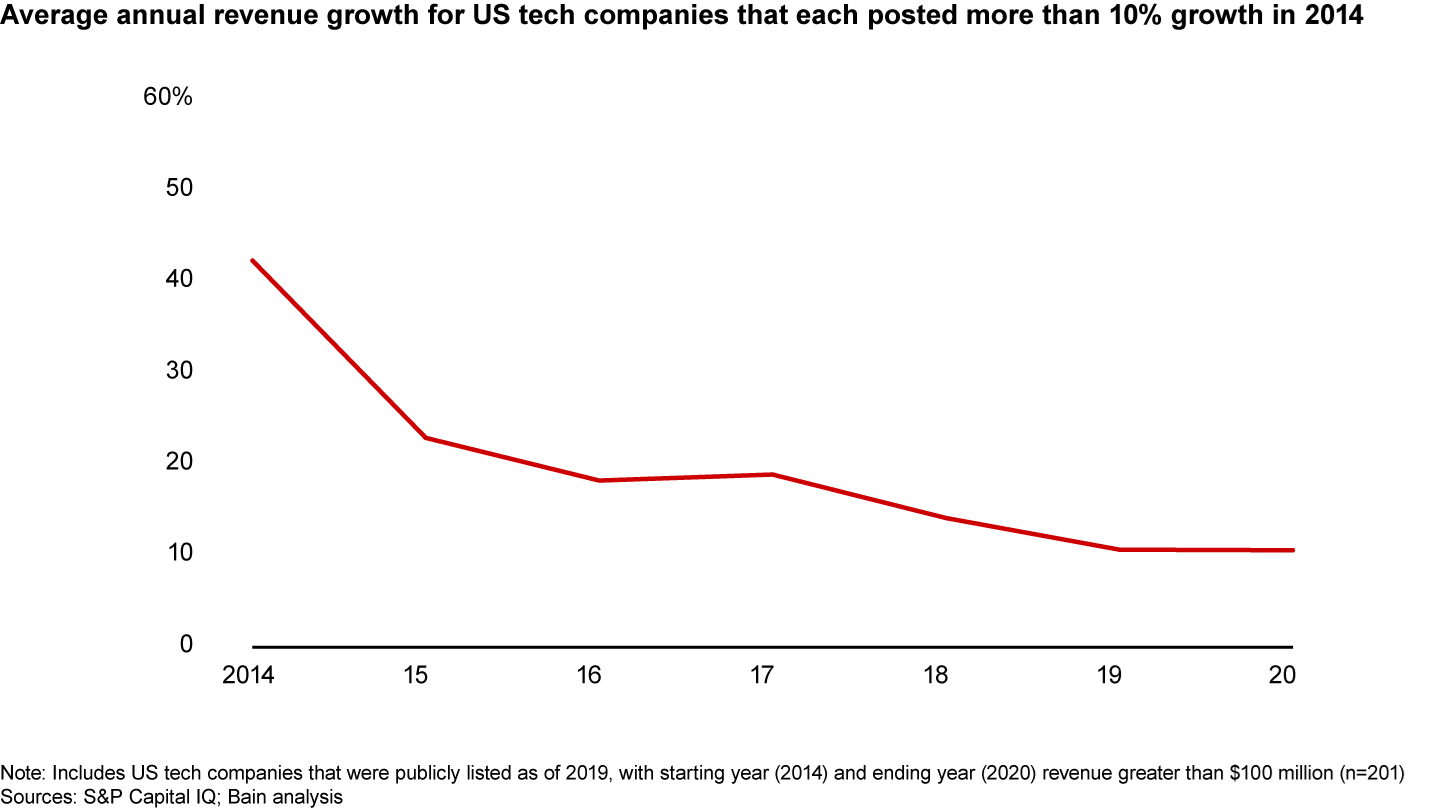
Crucially, equity markets also place more value on cost productivity gains in the technology sector than some might think, as shown by Bain & Company analysis of the stock market performance of all US-listed tech groups during the 2014–2019 period that preceded Covid-19’s turbulence. We found the strongest investor returns at companies that most consistently demonstrated cost productivity gains by increasing earnings before interest, taxes, depreciation, and amortization (EBITDA) faster than revenues, year after year (see Figure 2).
In tech, there’s a significant link between superior shareholder returns and sustained cost productivity improvement

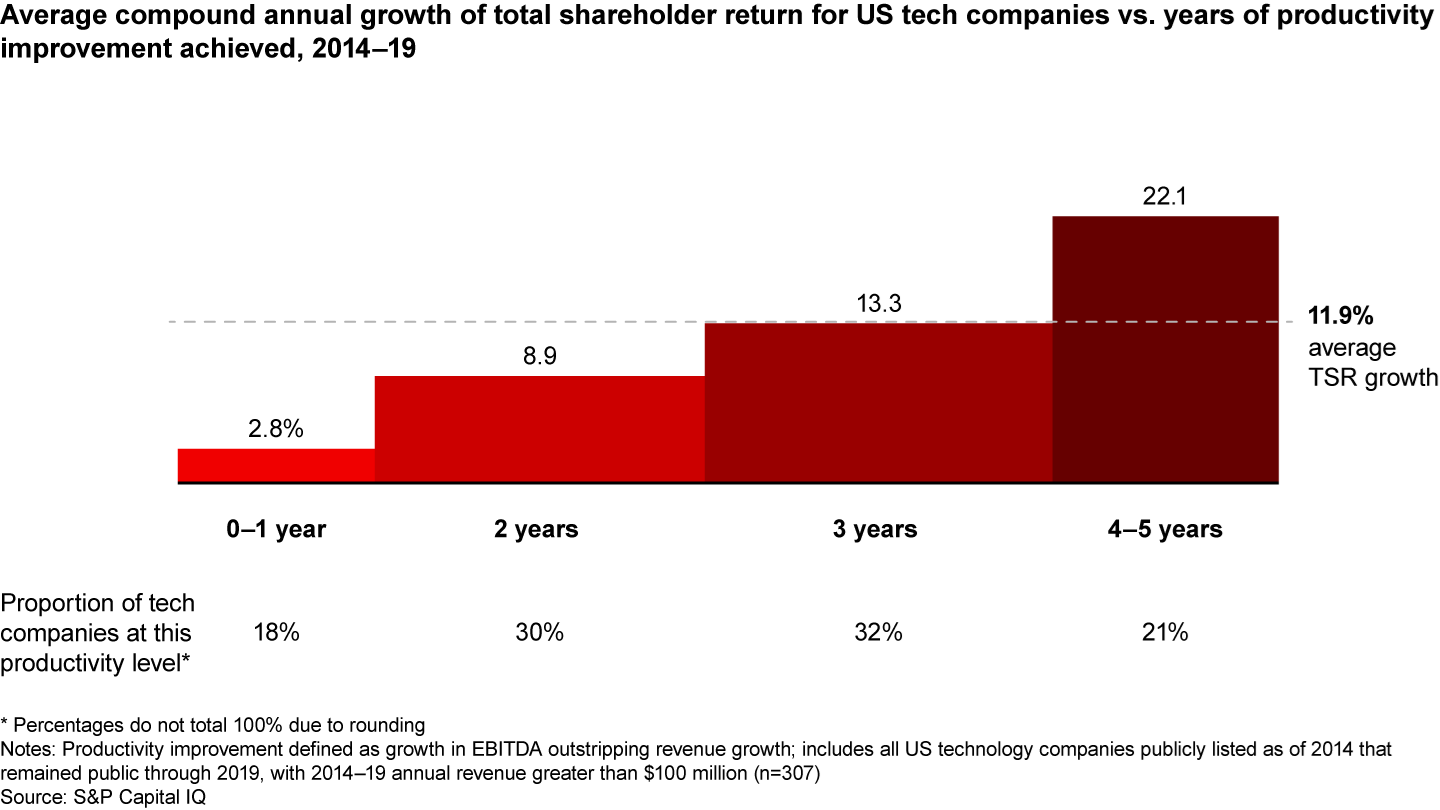
This is not simply a case of margins expanding as the business gains scale. Across all growth cohorts, companies that sustained productivity improvements for several years (“cost leaders”) outperformed all other companies in their growth peer group on total shareholder return (see Figure 3). Cost leaders follow a clear path to accomplish this feat. They invest in process and technology to achieve cost leadership vs. competitors, then reinvest that cash “fuel” internally to drive the next wave of growth.
The link between productivity gains and strong equity performance holds across fast-, medium-, and slow-growing tech companies

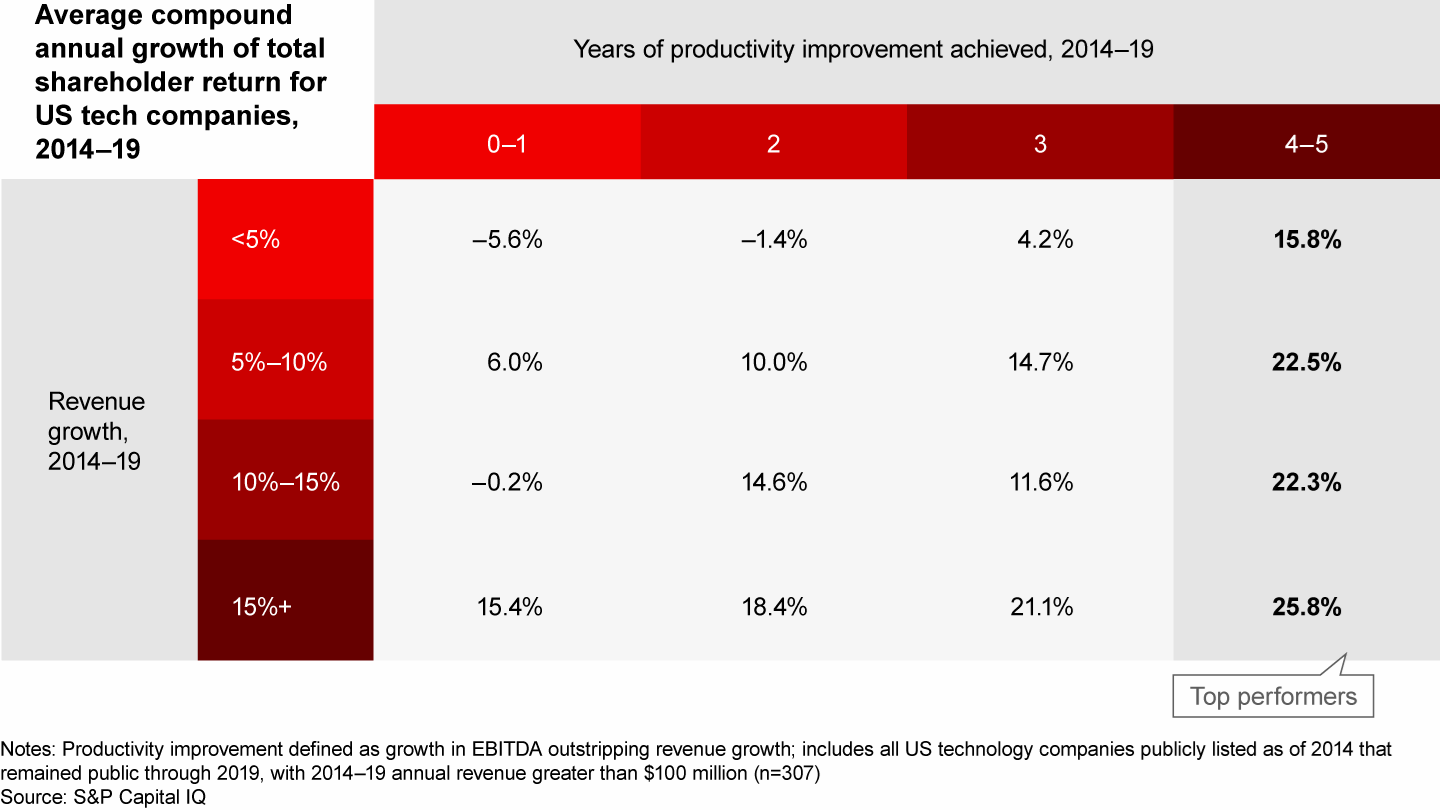
Fast-growing cost leaders in tech get a handful of things right
In our work with tech companies globally, we’ve identified patterns in how cost leaders repeat this cycle of saving and reinvestment. They tend to do a handful things well. For tech executive teams aspiring to cost leadership on top of growth, these five imperatives can help to shape a broad cost management strategy.
- Get high-resolution spending visibility. Management teams at cost leaders build up a more granular picture of spending than traditional management reporting allows. That high-resolution clarity enables executives and managers at all levels to fully and quickly understand where money is spent, who spends it, and whether it is being actively managed. In a growth business, where unit or revenue growth can become the excuse for runaway cost increases, this visibility is essential to avoid unchecked cost inflation.
- Differentiate between strategic and nonstrategic spending. Not all costs are created equal. Cost leaders don’t cut spending across the board by a set percentage. They distinguish between nonstrategic costs and spending that underpins critical customer experiences, effective R&D, high-return sales and marketing, and other strategic priorities where they need to outinvest competitors.
Salesforce is one example. While posting annual revenue increases topping 20%, the cloud software company prioritized strategic spending even as it expanded margins through tight cost control. For instance, it increased the proportion of its spending going into research and development. It was a similar story in sales and marketing: Strategic spending directed at driving market gains was unaffected by initiatives that cut the proportion of revenue spent on sales and marketing by almost 8 percentage points over five years, through measures such as centralizing work, encouraging self-service, and streamlining sales management.
Cost leaders also manage down nonstrategic costs through a rigorous annual and ongoing process, to drive investment in the growth of the business. This “investment posture” sets the stage for reshaping the company’s profit and loss statement, cost structure, and operating model, while signaling that productivity (absolute and unit cost) improvements will be expected in most areas of the company. - Inject clean-sheet rigor into budgeting. At many companies, there’s a tendency in the budgeting process to let costs drift upward in line with rising sales, inflation, and investment requests. Cost leaders break free of this default setting. Instead of indexing costs to growth, or allowing them to run ahead of sales increases, they invest in annual clean-sheet budgeting processes that consistently deliver quarterly unit cost improvements, while flattening or even managing down fixed costs.
- Embrace zero-basing and automation to eliminate unnecessary work. Tech cost leaders excel at cutting unnecessary work. They constantly reinvent customer-facing and internal processes to take out complexity and manual work, often guided by a zero-based redesign approach that scrutinizes what work is done and then how it is done.
Simplifying work and then streamlining it further with automation tools can yield sustained results. Take ServiceNow, the California-based provider of enterprise cloud computing solutions. It has thrived by overtly balancing sales growth and profitability, and part of that success has come from internally deploying the workflow platform it sells to other companies. It recently told investors that the platform had created $300 million in internal savings from increased employee productivity over three years—cash it reinvested in growth-generating areas such as IT innovation. - Move from efficiency basics to game changers. Cost leaders first get all the basic efficiency measures in place, such as trimming waste, managing third-party spending and staff expansions through budgeting, etc. They then move to more advanced or cross-functional game changers, such as truly zero-basing functions and costs, reducing product line and operating model complexity, and introducing large-scale automation (see Figure 4).
Bold moves are possible at the enterprise level and in most functions. In procurement, nailing the basics might mean consolidating all contingent labor needs to negotiate better rates. The most ambitious executive teams might then progress to game-changing moves such as embedding a company-wide vendor management system (VMS) into policies and practice. For instance, one software maker made VMS implementation and contingent labor consolidation a key plank of a broader company-wide efficiency drive that within a year freed up about $200 million in spending, for reinvestment in high-priority areas such as artificial intelligence.
Relentless cost management often means getting the productivity basics right and adding one or two game changers

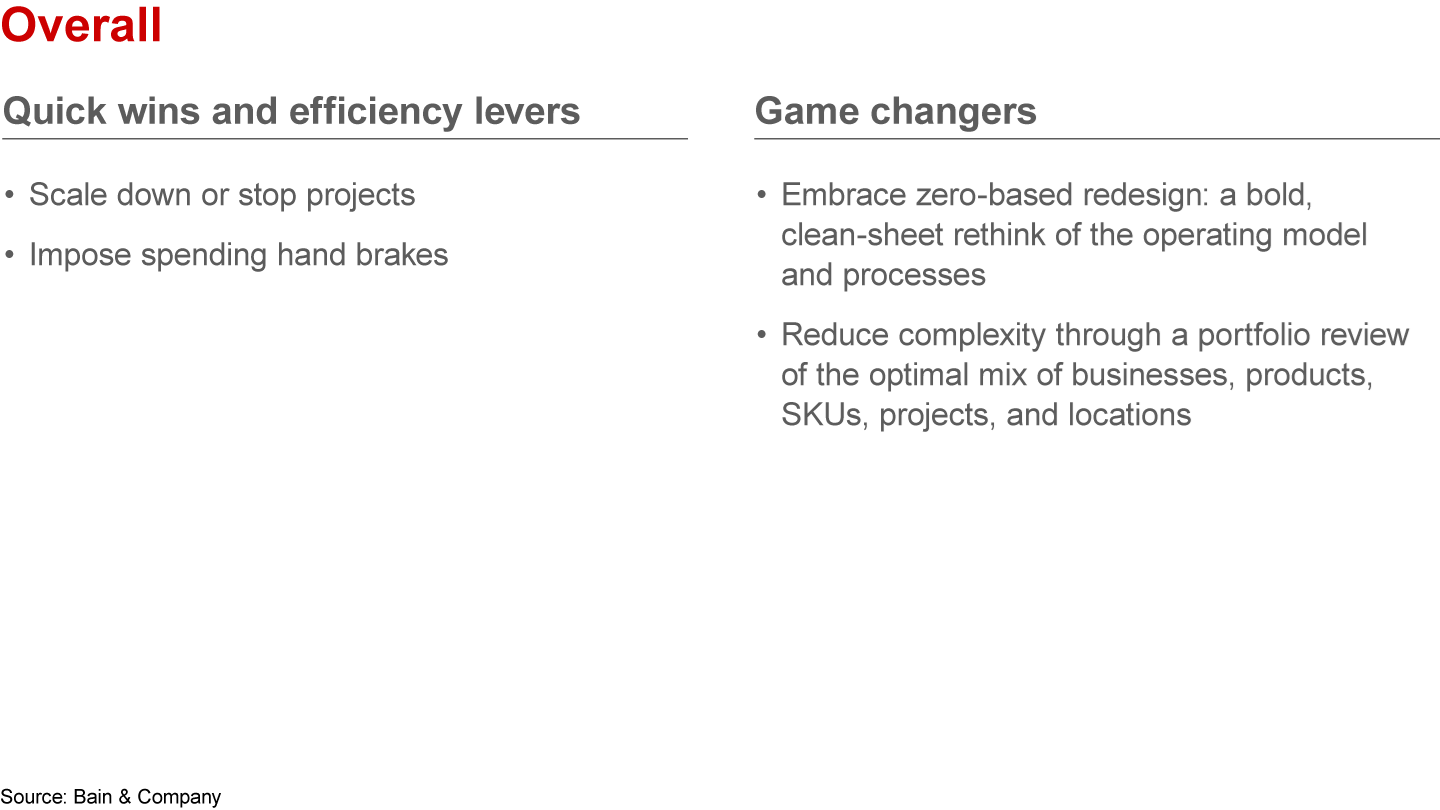
Relentless cost management often means getting the productivity basics right and adding one or two game changers

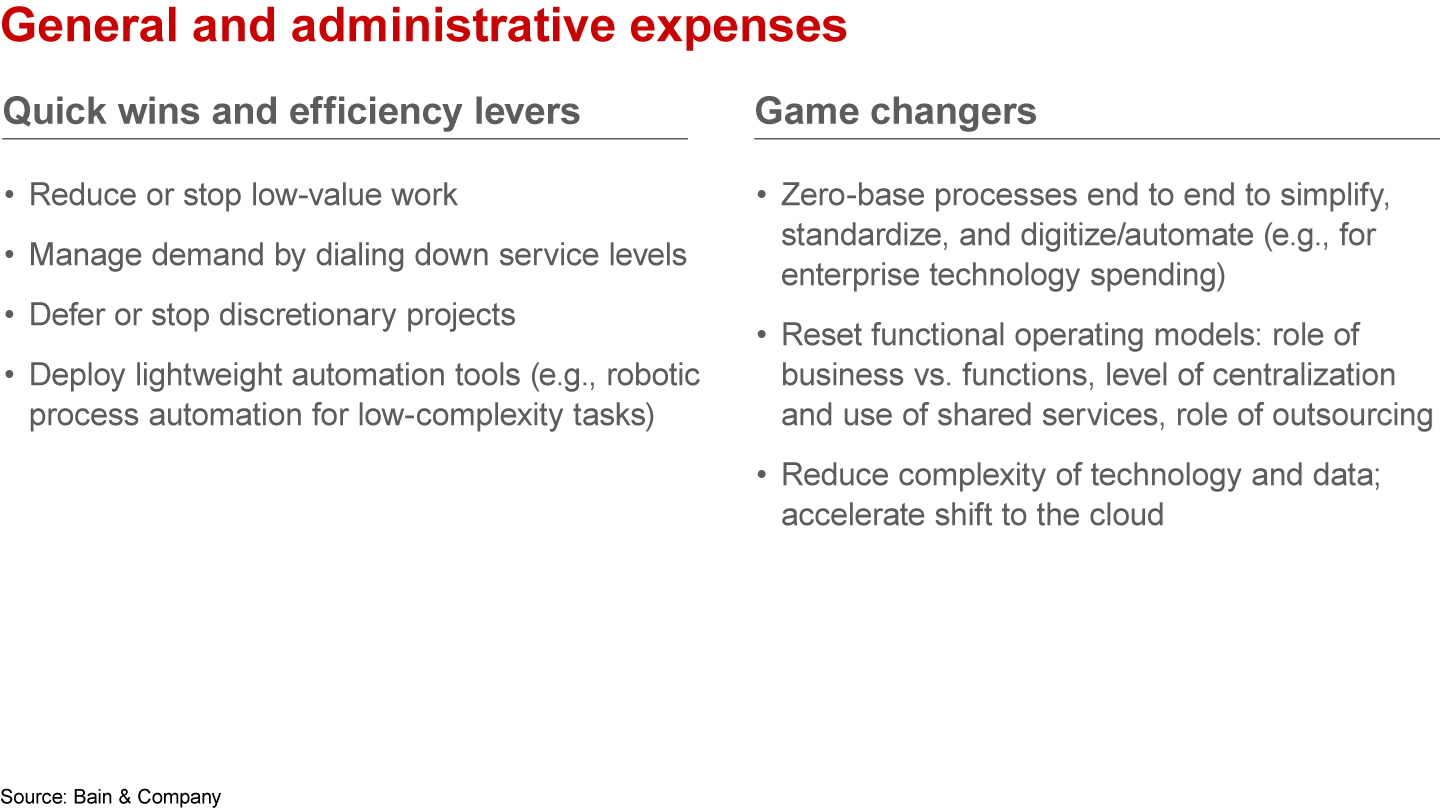
Relentless cost management often means getting the productivity basics right and adding one or two game changers

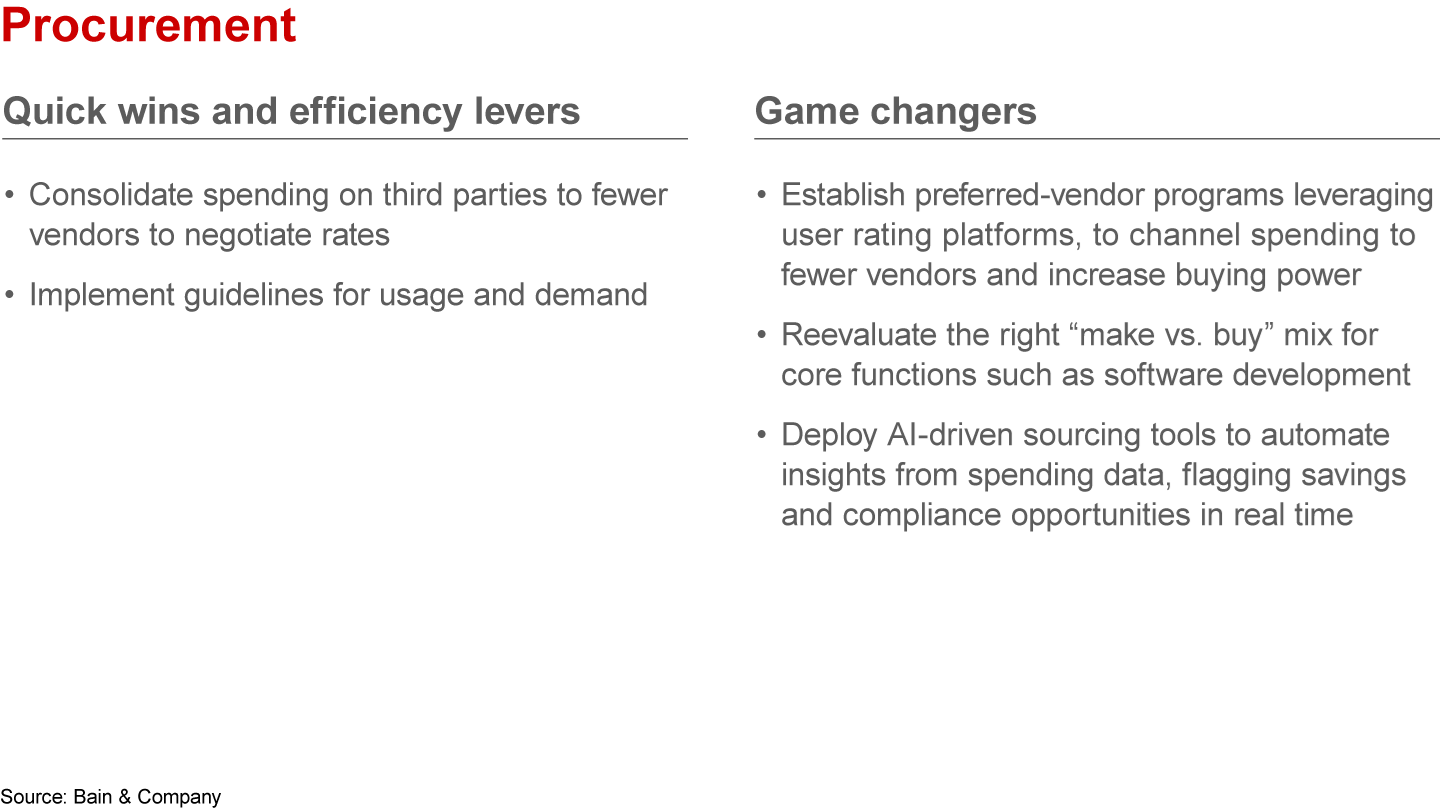
Relentless cost management often means getting the productivity basics right and adding one or two game changers

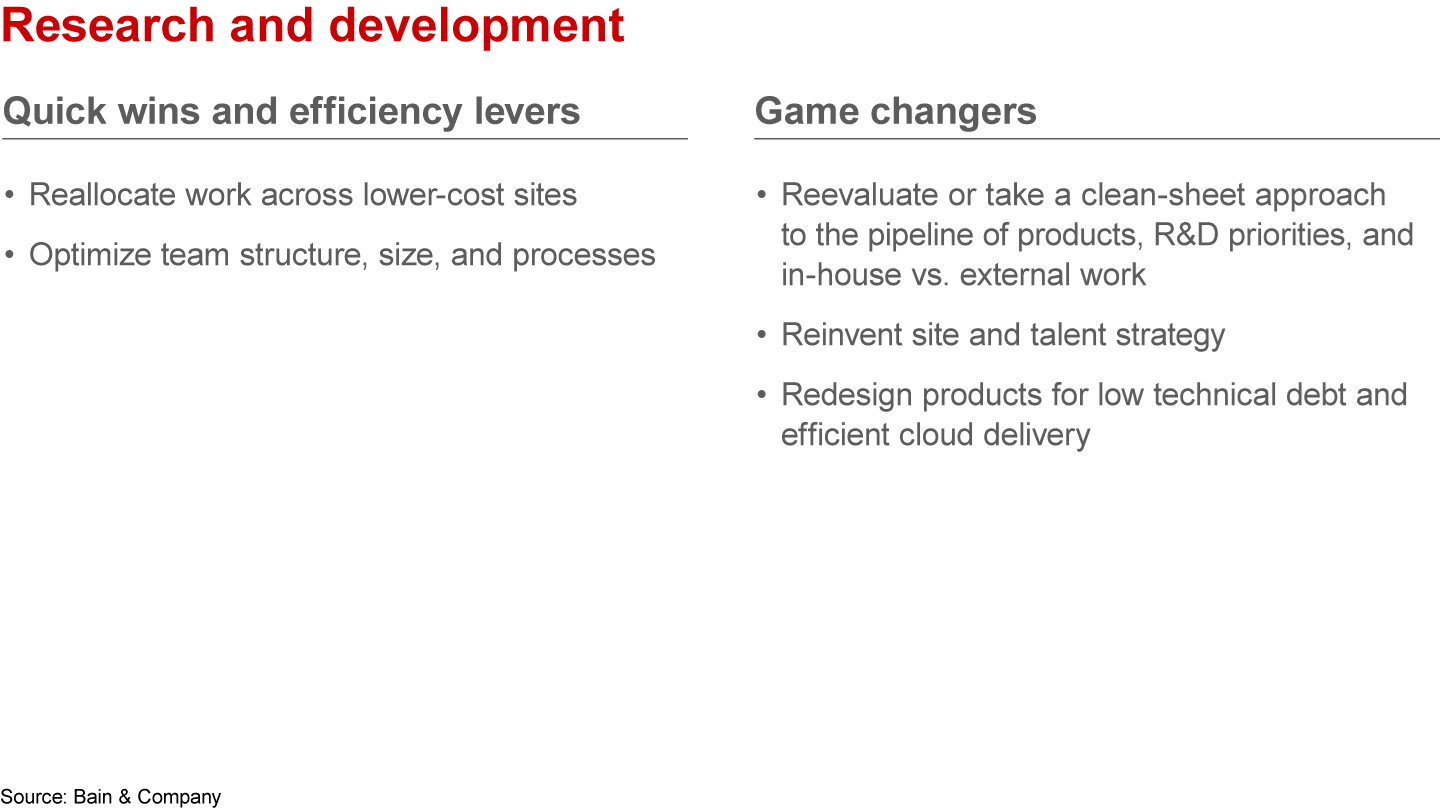
Relentless cost management often means getting the productivity basics right and adding one or two game changers

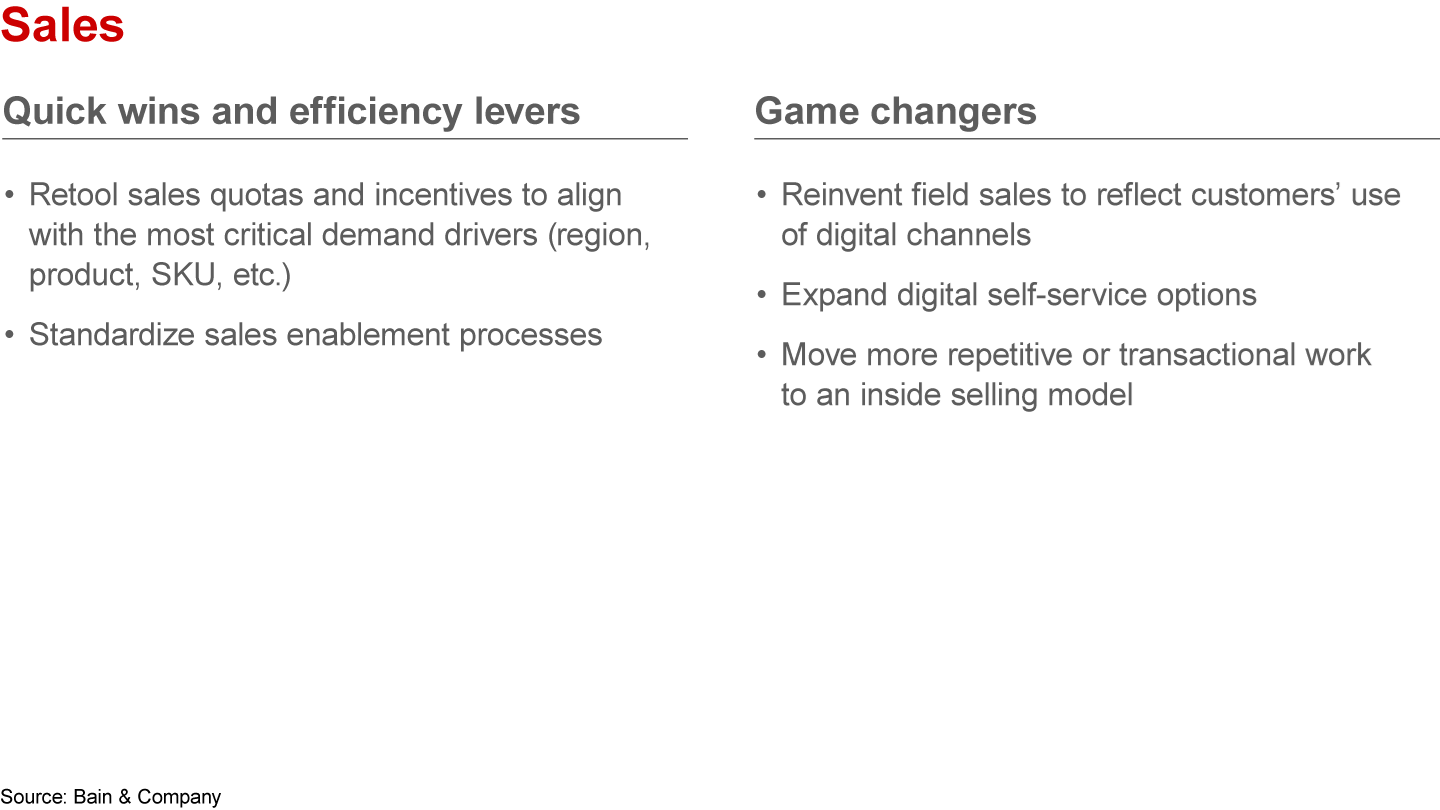
Relentless cost management often means getting the productivity basics right and adding one or two game changers

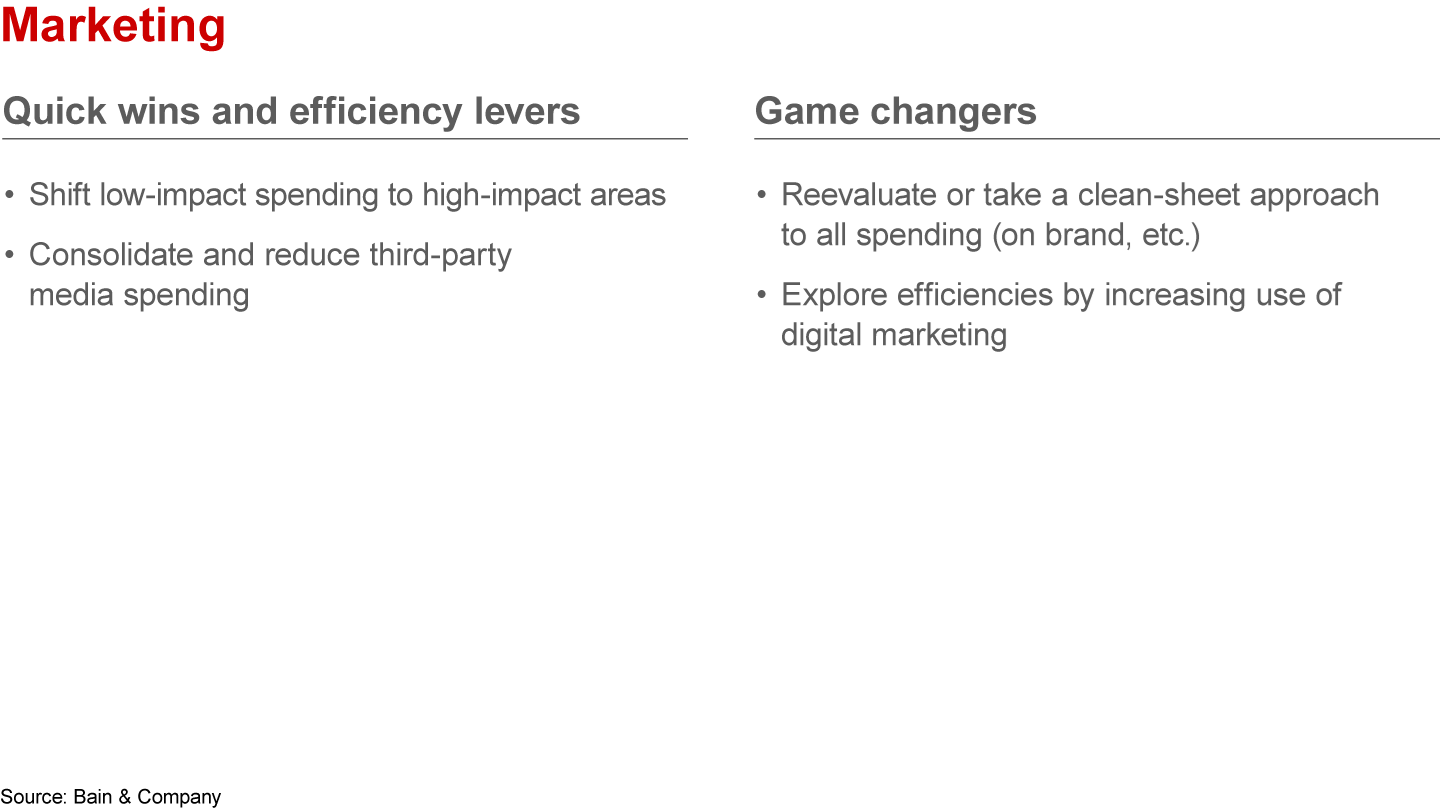
Relentless cost management often means getting the productivity basics right and adding one or two game changers

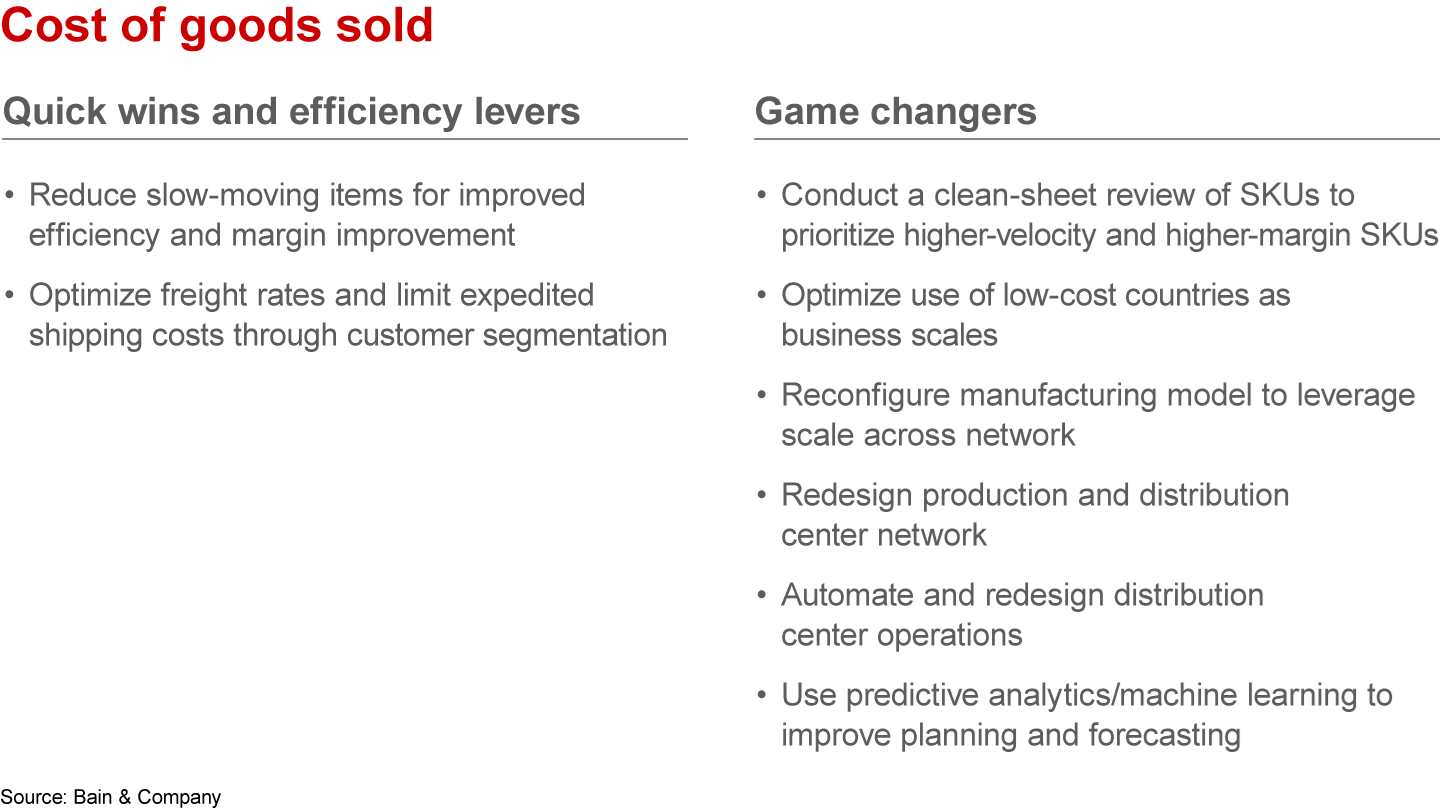
Getting started: Monday morning questions
As management teams weigh where and how to attack the challenge of sustained cost productivity, we suggest a few fundamental discussions around the following questions.
- Do we have full visibility into what we spend and who spends it?
- For each major cost area, how many years in a row have we achieved reductions in absolute cost or unit cost?
- Do all our leadership roles include a focus on annual improvements in efficiency or unit cost?
- Do we ever zero-base our approach to department or process costs, what work gets done, and how it gets done?
- Are we automating most repetitive, rules-based tasks?
- Does our procurement team find a 3%–5% reduction in external costs (adjusted for volume and inflation) each year?
- Are all our investments in R&D and marketing generating a positive return on investment?
The answers to these questions may well identify opportunities to be bolder on cost—and strengthen shareholder returns.